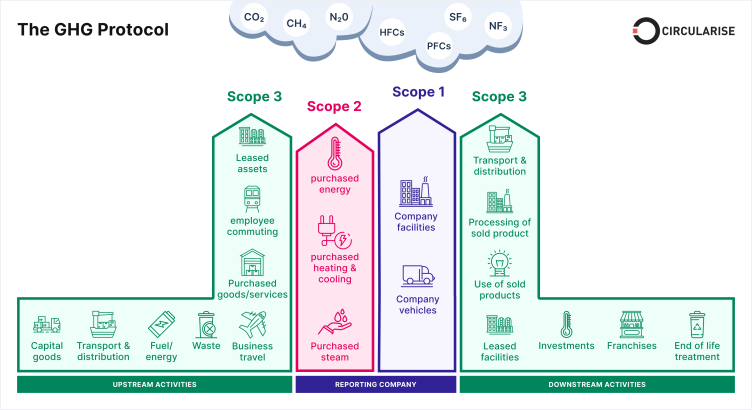
04 Oct, 2023
What are Scope 1, Scope 2, and Scope 3 Emissions: A Comprehensive Guide
In the battle against climate change, understanding and reducing greenhouse gas (GHG) emissions is crucial. To effectively tackle emissions, businesses must first comprehend the different scopes of emissions. This comprehensive guide will provide you with a deep understanding of Scope 1, Scope 2, and Scope 3 emissions, their definitions, and how they contribute to a company's carbon footprint.
Scope 1 Emissions: Direct Emissions
Scope 1 emissions encompass direct emissions produced by a company. These emissions are generated from sources that the company owns or controls. Examples of Scope 1 emissions include onsite energy use, such as space heating, refrigerants used in buildings, and fuel consumed by owned and leased vehicles. By measuring and tracking Scope 1 emissions, companies can identify areas where they can reduce their carbon footprint and implement targeted emission reduction strategies.
Scope 2 Emissions: Indirect Emissions
Scope 2 emissions refer to indirect emissions resulting from the purchase of electricity, steam, heating, and cooling. These emissions are associated with the generation of energy used by the company. By calculating Scope 2 emissions, businesses can gain insights into the environmental impact of their energy consumption and identify opportunities for energy efficiency and renewable energy adoption.
Scope 3 Emissions: Indirect Value Chain Emissions
Scope 3 emissions are the most complex and encompass indirect emissions that occur throughout a company's value chain. These emissions are generated from sources that are not owned or controlled by the company but are associated with its activities. Scope 3 emissions include a wide range of factors such as purchased goods and services, business travel, employee commuting, waste generation, and transportation and distribution tied to suppliers and customers. While Scope 3 emissions can be challenging to measure and track, they often represent a significant portion of a company's carbon footprint. Addressing Scope 3 emissions is crucial for achieving comprehensive emission reduction goals.
Why Measure All Three Scopes?
Measuring and tracking emissions across all three scopes is essential for several reasons. Firstly, it provides a comprehensive understanding of a company's carbon footprint, allowing for targeted emission reduction efforts. Secondly, reporting on all three scopes enhances transparency, builds customer trust, and improves brand reputation. Thirdly, measuring Scope 3 emissions helps identify emissions hotspots in the value chain, allowing businesses to collaborate with suppliers and customers to drive emission reduction efforts. Finally, comprehensive emissions reporting ensures compliance with regulatory requirements and demonstrates a commitment to sustainability.
The Importance of Carbon Accounting
Carbon accounting plays a crucial role in understanding and managing emissions. It involves quantifying and tracking GHG emissions from various sources within an organization. By utilizing carbon accounting methods and tools, businesses can calculate their carbon footprint and identify areas where emissions can be reduced. Carbon accounting also helps in setting science-based emission reduction targets, reporting on sustainability efforts, and ensuring compliance with regulatory standards.
The Greenhouse Gas Protocol
The Greenhouse Gas Protocol (GHG Protocol) is a widely recognized standard for measuring and reporting GHG emissions. It provides a framework for classifying emissions into different scopes and defines the boundaries and methodologies for calculating emissions. The GHG Protocol's three scopes align with the concepts of Scope 1, Scope 2, and Scope 3 emissions discussed earlier in this guide. Adhering to the GHG Protocol enables businesses to adopt a standardized approach to emissions reporting and facilitates comparisons across different organizations and sectors.
The Significance of Upstream and Downstream Emissions
In addition to the three scopes, it is essential to consider upstream and downstream emissions. Upstream emissions refer to the environmental impacts associated with the extraction, production, and transportation of raw materials and energy sources required for a product or process. These emissions occur before the final manufacturing or operation stage. On the other hand, downstream emissions encompass the environmental impacts that occur after the product has been manufactured or the process has taken place. These emissions are associated with the distribution, use, maintenance, and disposal of the product. Understanding both upstream and downstream emissions is crucial for a comprehensive assessment of a product's or process's environmental footprint.
Benefits of Reporting Scope Emissions
Reporting on Scope 1, Scope 2, and Scope 3 emissions offers numerous benefits for organizations. Firstly, it improves transparency, enhances customer trust, and strengthens brand reputation. Secondly, emissions reporting helps identify the climate maturity of key value chain players and enables the identification of emission hotspots and weaknesses. Thirdly, it provides a better understanding of exposure to resource, energy, and climate-related risks. Additionally, emissions reporting can lead to lower energy and resource costs, positive employee and consumer engagement, and compliance with regulatory requirements.
Conclusion
Understanding and managing Scope 1, Scope 2, and Scope 3 emissions is crucial for businesses committed to reducing their carbon footprint and addressing climate change. By measuring and tracking emissions across all three scopes, organizations can identify emission reduction opportunities, enhance transparency, and align with global sustainability agendas. Carbon accounting, adherence to reporting standards like the GHG Protocol, and consideration of upstream and downstream emissions further contribute to comprehensive emissions management. Embracing emissions reporting and reduction efforts positions businesses as leaders in the transition to a low-carbon economy.